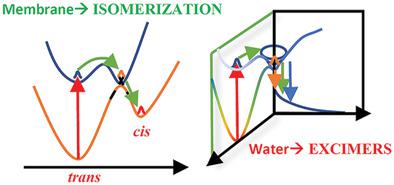Our official English website, www.x-mol.net, welcomes your
feedback! (Note: you will need to create a separate account there.)
Membrane Environment Enables Ultrafast Isomerization of Amphiphilic Azobenzene.
Advanced Science ( IF 14.3 ) Pub Date : 2020-03-06 , DOI: 10.1002/advs.201903241 Giuseppe Maria Paternò 1 , Elisabetta Colombo 2, 3 , Vito Vurro 1, 4 , Francesco Lodola 1 , Simone Cimò 5 , Valentina Sesti 5 , Egle Molotokaite 1 , Mattia Bramini 2, 3, 6 , Lucia Ganzer 4 , Daniele Fazzi 7 , Cosimo D'Andrea 1, 4 , Fabio Benfenati 2, 3 , Chiara Bertarelli 5 , Guglielmo Lanzani 1, 4
Advanced Science ( IF 14.3 ) Pub Date : 2020-03-06 , DOI: 10.1002/advs.201903241 Giuseppe Maria Paternò 1 , Elisabetta Colombo 2, 3 , Vito Vurro 1, 4 , Francesco Lodola 1 , Simone Cimò 5 , Valentina Sesti 5 , Egle Molotokaite 1 , Mattia Bramini 2, 3, 6 , Lucia Ganzer 4 , Daniele Fazzi 7 , Cosimo D'Andrea 1, 4 , Fabio Benfenati 2, 3 , Chiara Bertarelli 5 , Guglielmo Lanzani 1, 4
Affiliation

|
The non-covalent affinity of photoresponsive molecules to biotargets represents an attractive tool for achieving effective cell photo-stimulation. Here, an amphiphilic azobenzene that preferentially dwells within the plasma membrane is studied. In particular, its isomerization dynamics in different media is investigated. It is found that in molecular aggregates formed in water, the isomerization reaction is hindered, while radiative deactivation is favored. However, once protected by a lipid shell, the photochromic molecule reacquires its ultrafast photoisomerization capacity. This behavior is explained considering collective excited states that may form in aggregates, locking the conformational dynamics and redistributing the oscillator strength. By applying the pump probe technique in different media, an isomerization time in the order of 10 ps is identified and the deactivation in the aggregate in water is also characterized. Finally, it is demonstrated that the reversible modulation of membrane potential of HEK293 cells via illumination with visible light can be indeed related to the recovered trans→cis photoreaction in lipid membrane. These data fully account for the recently reported experiments in neurons, showing that the amphiphilic azobenzenes, once partitioned in the cell membrane, are effective light actuators for the modification of the electrical state of the membrane.
中文翻译:

膜环境实现两亲性偶氮苯的超快异构化。
光响应分子与生物靶标的非共价亲和力是实现有效细胞光刺激的一种有吸引力的工具。在这里,研究了优先驻留在质膜内的两亲性偶氮苯。特别是,研究了其在不同介质中的异构化动力学。研究发现,在水中形成的分子聚集体中,异构化反应受到阻碍,而辐射失活反应则受到促进。然而,一旦受到脂质壳的保护,光致变色分子就会重新获得其超快的光异构化能力。这种行为的解释是考虑到可能在聚集体中形成的集体激发态,锁定构象动力学并重新分配振荡器强度。通过在不同介质中应用泵探针技术,可以识别出 10 ps 左右的异构化时间,并且还可以表征水中聚集体的失活。最后,证明通过可见光照射对 HEK293 细胞膜电位的可逆调节确实与脂质膜中恢复的反式→顺式光反应有关。这些数据充分解释了最近报道的神经元实验,表明两亲性偶氮苯一旦在细胞膜中分配,就成为改变膜电状态的有效光致动器。
更新日期:2020-04-21
中文翻译:

膜环境实现两亲性偶氮苯的超快异构化。
光响应分子与生物靶标的非共价亲和力是实现有效细胞光刺激的一种有吸引力的工具。在这里,研究了优先驻留在质膜内的两亲性偶氮苯。特别是,研究了其在不同介质中的异构化动力学。研究发现,在水中形成的分子聚集体中,异构化反应受到阻碍,而辐射失活反应则受到促进。然而,一旦受到脂质壳的保护,光致变色分子就会重新获得其超快的光异构化能力。这种行为的解释是考虑到可能在聚集体中形成的集体激发态,锁定构象动力学并重新分配振荡器强度。通过在不同介质中应用泵探针技术,可以识别出 10 ps 左右的异构化时间,并且还可以表征水中聚集体的失活。最后,证明通过可见光照射对 HEK293 细胞膜电位的可逆调节确实与脂质膜中恢复的反式→顺式光反应有关。这些数据充分解释了最近报道的神经元实验,表明两亲性偶氮苯一旦在细胞膜中分配,就成为改变膜电状态的有效光致动器。











































 京公网安备 11010802027423号
京公网安备 11010802027423号